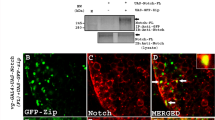Abstract.
Two groups of genes, the Polycomb group (Pc-G) and trithorax group (trx-G), have been identified in Drosophila to provide a transcriptional memory mechanism. They ensure the maintenance of transcription patterns of key regulators such as the Hox genes and thereby the correct execution of developmental programmes. Recent data suggest that this memory mechanism is conserved in vertebrates and plants. Here we discuss current insights into the role of mouse Pc-G genes, with a particular focus on the best-studied Bmi1, Mel18 and M33 genes, as representative examples. Common phenotypes observed in knockout mice mutant for each of these genes indicate an important role for Pc-G genes not only in regulation of Hox gene expression and axial skeleton development but also in control of proliferation and survival of haematopoietic cell lineages. Proliferation defects are also observed in other cell lineages derived from these null-mutant mice, and provide new tools to study the impact of Pc-G deregulation on cell cycle control.
Similar content being viewed by others
Author information
Authors and Affiliations
Rights and permissions
About this article
Cite this article
van Lohuizen, M. Functional analysis of mouse Polycomb group genes. CMLS, Cell. Mol. Life Sci. 54, 71–79 (1998). https://doi.org/10.1007/s000180050126
Issue Date:
DOI: https://doi.org/10.1007/s000180050126




